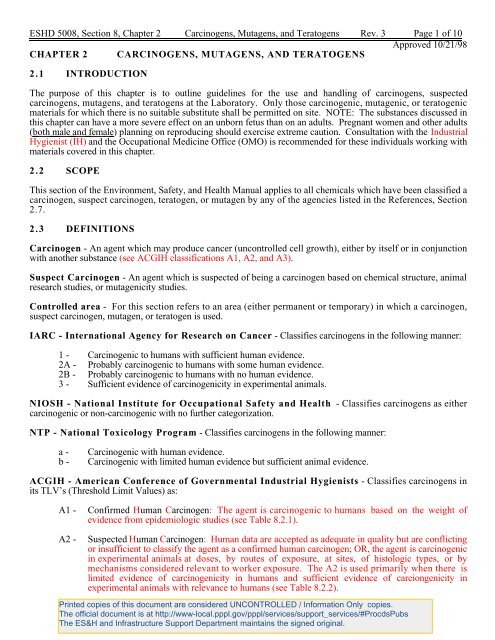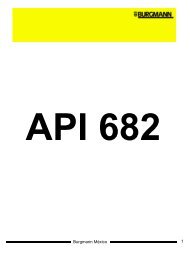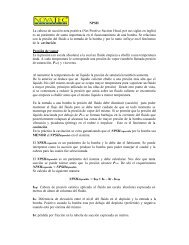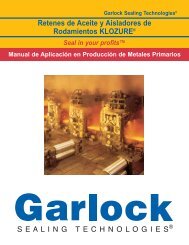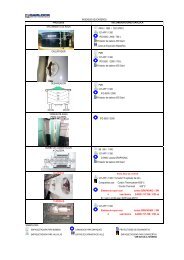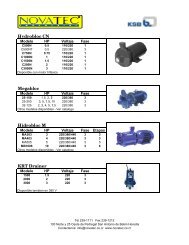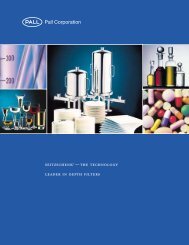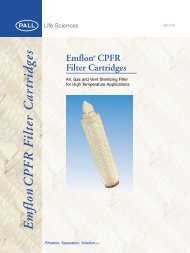Carcinogens, mutagens, and teratogens - NOVATEC Industrial SA
Carcinogens, mutagens, and teratogens - NOVATEC Industrial SA
Carcinogens, mutagens, and teratogens - NOVATEC Industrial SA
Create successful ePaper yourself
Turn your PDF publications into a flip-book with our unique Google optimized e-Paper software.
ESHD 5008, Section 8, Chapter 2 <strong>Carcinogens</strong>, Mutagens, <strong>and</strong> Teratogens Rev. 3 Page 1 of 10<br />
Approved 10/21/98<br />
CHAPTER 2 CARCINOGENS, MUTAGENS, AND TERATOGENS<br />
2.1 INTRODUCTION<br />
The purpose of this chapter is to outline guidelines for the use <strong>and</strong> h<strong>and</strong>ling of carcinogens, suspected<br />
carcinogens, <strong>mutagens</strong>, <strong>and</strong> <strong>teratogens</strong> at the Laboratory. Only those carcinogenic, mutagenic, or teratogenic<br />
materials for which there is no suitable substitute shall be permitted on site. NOTE: The substances discussed in<br />
this chapter can have a more severe effect on an unborn fetus than on an adults. Pregnant women <strong>and</strong> other adults<br />
( both male <strong>and</strong> female ) planning on reproducing should exercise extreme caution. Consultation with the <strong>Industrial</strong><br />
Hygienist (IH) <strong>and</strong> the Occupational Medicine Office (OMO) is recommended for these individuals working with<br />
materials covered in this chapter.<br />
2.2 SCOPE<br />
This section of the Environment, Safety, <strong>and</strong> Health Manual applies to all chemicals which have been classified a<br />
carcinogen, suspect carcinogen, teratogen, or mutagen by any of the agencies listed in the References, Section<br />
2.7.<br />
2.3 DEFINITIONS<br />
Carcinogen - An agent which may produce cancer (uncontrolled cell growth), either by itself or in conjunction<br />
with another substance (see ACGIH classifications A1, A2, <strong>and</strong> A3).<br />
Suspect Carcinogen - An agent which is suspected of being a carcinogen based on chemical structure, animal<br />
research studies, or mutagenicity studies.<br />
Controlled area - For this section refers to an area (either permanent or temporary) in which a carcinogen,<br />
suspect carcinogen, mutagen, or teratogen is used.<br />
IARC - International Agency for Research on Cancer - Classifies carcinogens in the following manner:<br />
1 - Carcinogenic to humans with sufficient human evidence.<br />
2A - Probably carcinogenic to humans with some human evidence.<br />
2B - Probably carcinogenic to humans with no human evidence.<br />
3 - Sufficient evidence of carcinogenicity in experimental animals.<br />
NIOSH - National Institute for Occupational Safety <strong>and</strong> Health - Classifies carcinogens as either<br />
carcinogenic or non-carcinogenic with no further categorization.<br />
NTP - National Toxicology Program - Classifies carcinogens in the following manner:<br />
a -<br />
b -<br />
Carcinogenic with human evidence.<br />
Carcinogenic with limited human evidence but sufficient animal evidence.<br />
ACGIH - American Conference of Governmental <strong>Industrial</strong> Hygienists - Classifies carcinogens in<br />
its TLV’s (Threshold Limit Values) as:<br />
A1 -<br />
A2 -<br />
Confirmed Human Carcinogen: The agent is carcinogenic to humans based on the weight of<br />
evidence from epidemiologic studies (see Table 8.2.1).<br />
Suspected Human Carcinogen: Human data are accepted as adequate in quality but are conflicting<br />
or insufficient to classify the agent as a confirmed human carcinogen; OR, the agent is carcinogenic<br />
in experimental animals at doses, by routes of exposure, at sites, of histologic types, or by<br />
mechanisms considered relevant to worker exposure. The A2 is used primarily when there is<br />
limited evidence of carcinogenicity in humans <strong>and</strong> sufficient evidence of carciongenicity in<br />
experimental animals with relevance to humans (see Table 8.2.2).
ESHD 5008, Section 8, Chapter 2 <strong>Carcinogens</strong>, Mutagens, <strong>and</strong> Teratogens Rev. 3 Page 2 of 10<br />
A3 - Confirmed Animal Carcinogen with Unknown Relevance to Humans: The agent is carcinogenic in<br />
experimental animals at a relatively high dose, by routes of administration, at sites, or histologic<br />
types, or by mechanisms that may not be relevant to worker exposure. Available epidemiologic<br />
studies do not confirm an increased risk of cancer in exposed humans. Available evidence does<br />
not suggest that the agent is likely to cause cancer in humans except under uncommon or unlikely<br />
routes or levels of exposure (see Table 8.2.3).<br />
A4 -<br />
A5 -<br />
Not Classifiable as a Human Carcinogen: Agents which cause concern that they could be<br />
carcinogenic for humans but which cannot be assessed conclusively because of a lack of data.<br />
Not Suspected as a Human Carcinogen: The agent is not suspected to be a human carcinogen on<br />
the basis of properly conducted epidemiologic studies in humans.<br />
Teratogen - A substance which can cause physical defects in a developing embryo.<br />
Mutagen - A material that induces genetic changes (mutations) in the DNA.<br />
Asbestos - A generic term applied to a wide variety of naturally occurring fibrous mineral silicates which occur<br />
as bundles of minute fibers <strong>and</strong> can be separated into fibers that are smaller than human hair.<br />
Friable Asbestos - Asbestos containing material that can be broken up by h<strong>and</strong> pressure <strong>and</strong> consequently<br />
release fibers into the air.<br />
Non-Friable Asbestos - Asbestos containing materials bonded into a form which will not easily release fibers<br />
to the air.<br />
2.4 RESPONSIBILITIES<br />
2.4.1 Department Chairman/Division Heads are responsible for ensuring the implementation of this section.<br />
2.4.2 Line Supervisors are responsible for:<br />
A. Informing the <strong>Industrial</strong> Hygienist (IH) of the proposed use of a carcinogen, mutagen, or<br />
teratogen.<br />
B. Searching for a suitable substitute for the present or proposed use of a carcinogen, mutagen, or<br />
teratogen with assistance from the IH.<br />
C. Installing <strong>and</strong> maintaining the proper engineering controls to control exposure to carcinogens,<br />
<strong>mutagens</strong>, or <strong>teratogens</strong>.<br />
D. Ensuring that subordinates have been trained in the proper h<strong>and</strong>ling, storage, <strong>and</strong> hazards of<br />
carcinogens, <strong>mutagens</strong>, or <strong>teratogens</strong>.<br />
E. Enforcing the use of personal protective equipment (PPE), as per Section 8.6, where its use is<br />
required.<br />
F. Ensuring that the proper PPE is on h<strong>and</strong> in sufficient quantities for employees <strong>and</strong> visitors required<br />
to wear it.<br />
G. Ensuring that subordinates are h<strong>and</strong>ling the carcinogens, <strong>mutagens</strong>, or <strong>teratogens</strong> in the manner<br />
outlined <strong>and</strong> approved by the IH.<br />
H. Posting a written <strong>and</strong> IH approved procedure for the h<strong>and</strong>ling of the carcinogen, mutagen, or<br />
teratogen contaminated PPE.
ESHD 5008, Section 8, Chapter 2 <strong>Carcinogens</strong>, Mutagens, <strong>and</strong> Teratogens Rev. 3 Page 3 of 10<br />
I. Ensuring the integrity of a controlled area.<br />
J. Posting warning signs in controlled areas.<br />
2.4.3 The <strong>Industrial</strong> Hygienist (IH) is responsible for:<br />
A. Assisting supervisors in the search for a suitable substitute for the present or proposed use of a<br />
carcinogen, mutagen, or teratogen.<br />
B. Specifying the correct procedures to be used in h<strong>and</strong>ling a carcinogen, mutagen, or teratogen to<br />
supervisors, <strong>and</strong> employees.<br />
C. Training supervisors <strong>and</strong> workers on the correct h<strong>and</strong>ling <strong>and</strong> storing of carcinogens, <strong>mutagens</strong>,<br />
<strong>and</strong> <strong>teratogens</strong>.<br />
D. Assisting maintenance <strong>and</strong> supervisors in the design <strong>and</strong> installation of engineering controls,<br />
including ventilation.<br />
E. Reviewing <strong>and</strong> giving approval for design specifications for facilities <strong>and</strong> the h<strong>and</strong>ling <strong>and</strong> storage<br />
procedures for carcinogens, <strong>mutagens</strong>, <strong>and</strong> <strong>teratogens</strong>.<br />
F. Periodically monitoring for air contaminants to ensure worker safety.<br />
G. Periodically inspecting the h<strong>and</strong>ling <strong>and</strong> storage areas <strong>and</strong> procedures to ensure worker safety.<br />
2.4.4 The Operations <strong>and</strong> Maintenance Division is responsible for: designing, installing, <strong>and</strong> maintaining<br />
engineering controls, including ventilation systems (Chapter 4), <strong>and</strong> incorporating the criteria developed by the<br />
IH <strong>and</strong> supervisors.<br />
2.4.5 Procurement is responsible for complying with Section 8, Chapter 13, “ES&H Review of<br />
Procurements” for chemical requisition review <strong>and</strong> not ordering any chemical before it is approved by the IH.<br />
2.4.6 Quality Assurance is responsible for auditing compliance with this Chapter.<br />
2.4.7 All other employees are responsible for:<br />
A. Wearing <strong>and</strong> using the PPE issued to them in accordance with instructions <strong>and</strong> training provided<br />
by the IH <strong>and</strong> their supervisors.<br />
B. The proper cleaning, maintenance, <strong>and</strong> storage of the PPE as per instructions from the IH <strong>and</strong> their<br />
supervisors.<br />
C. Using only those types of PPE that have been recommended to them by their supervisors or the<br />
IH.<br />
D. Reporting malfunctioning engineering controls <strong>and</strong> ventilation systems to their supervisors.<br />
E. Following the h<strong>and</strong>ling instructions in accordance with procedures set down by the IH <strong>and</strong> their<br />
supervisors.<br />
2.5 REQUIREMENTS<br />
2.5.1 All Laboratory use of carcinogens, <strong>mutagens</strong> <strong>and</strong> <strong>teratogens</strong> shall meet or exceed the requirements <strong>and</strong><br />
regulations of the Occupational Safety <strong>and</strong> Health Administration (OSHA), the U.S. Department of Energy<br />
(DOE), the Environmental Protection Agency (EPA), <strong>and</strong> the guidelines set by the American Conference of<br />
Governmental <strong>Industrial</strong> Hygienists (ACGIH) <strong>and</strong> the National Institute for Occupational Safety <strong>and</strong> Health<br />
(NIOSH).
ESHD 5008, Section 8, Chapter 2 <strong>Carcinogens</strong>, Mutagens, <strong>and</strong> Teratogens Rev. 3 Page 4 of 10<br />
2.5.2 All proposed <strong>and</strong> present use <strong>and</strong> h<strong>and</strong>ling of carcinogens, <strong>mutagens</strong>, <strong>and</strong> <strong>teratogens</strong> must be approved<br />
by the IH. A requisitioner must get approval from the IH before a carcinogen, mutagen or teratogen can be<br />
purchased (see Chapter 13). The IH will assist in the identification of a material as to its carcinogenicity,<br />
mutagenicity, or teratogenicity.<br />
2.5.3 All uses <strong>and</strong> h<strong>and</strong>ling of carcinogens, <strong>mutagens</strong>, <strong>and</strong> <strong>teratogens</strong> will meet the most stringent regulations<br />
set down by any regulatory agency. This includes regulations or recommendations from the agencies mentioned<br />
in Section 2.5.1. A list of carcinogens identified by an agency is available from the IH.<br />
2.6 PRACTICES AND PROCEDURES<br />
2.6.1 General Laboratory Controls - The following practices must be followed whenever confirmed human<br />
carcinogens, <strong>mutagens</strong>, or <strong>teratogens</strong> (class A1, see Table 8.2.1) <strong>and</strong> should be followed where class A2 <strong>and</strong> A3<br />
carcinogens (as determined by the IH) are h<strong>and</strong>led in the Laboratory <strong>and</strong> no suitable substitutes can be found:<br />
A. Entrance to the area where the carcinogen, mutagen, or teratogen is being used shall be restricted to<br />
personnel directly involved in experimentation or required services, <strong>and</strong> signs shall be posted at the<br />
entrances to the area (see Figure 8.2.1).<br />
B. Local ventilation in the form of fume hoods <strong>and</strong> close-capture systems shall be available for any<br />
experiment that produces significant amounts of airborne gas, vapor, or particulate. These systems<br />
shall be of the "once through" type; no recirculation of exhaust air will be permitted.<br />
C. Eating, drinking, tobacco or gum chewing, food storage, smoking, <strong>and</strong> application of cosmetics<br />
shall be prohibited in the laboratory work area.<br />
D. Mechanical pipetting aids shall be used for all pipetting procedures.<br />
E. Solid <strong>and</strong> liquid wastes shall be properly labeled <strong>and</strong> collected separately in non-permeable<br />
containers <strong>and</strong> shall be disposed of through the Environmental Restoration/Waste Management<br />
(ER/WM) Division.<br />
F. Separate receptacles for non-contaminated broken glass shall be provided in all laboratory work<br />
areas.<br />
G. Hypodermic syringes shall be disposed of in disposal containers designed for sharps.<br />
H. Laboratory floor <strong>and</strong> bench-top surfaces shall be made of, or be covered with, a non-permeable<br />
material such as stainless steel or polyethylene to facilitate clean-up of spilled materials.<br />
I. <strong>Carcinogens</strong>, <strong>mutagens</strong>, <strong>and</strong> <strong>teratogens</strong> are also subject to all other applicable policies in the<br />
Environment, Safety <strong>and</strong> Health (ES&H) Manual such as Section 5.0 for flammable liquids.<br />
Where a conflict occurs, the most stringent policy shall apply.<br />
J. Safety-shower <strong>and</strong> eye-wash facilities shall be located within, or in close proximity to, the<br />
laboratory.<br />
K. All containers shall be clearly marked as to general hazard <strong>and</strong> complete chemical contents.<br />
L. Emergency action plans shall be included in the st<strong>and</strong>ard operating procedure.<br />
M. The workplace shall only be exposed to the amount of material needed to complete the project, <strong>and</strong><br />
no quantity of material greater than what is needed should be purchased. Excess chemicals <strong>and</strong><br />
unusable equipment should be disposed of once the project is completed through ER/WM.
ESHD 5008, Section 8, Chapter 2 <strong>Carcinogens</strong>, Mutagens, <strong>and</strong> Teratogens Rev. 3 Page 5 of 10<br />
2.6.2 Personal Protective Equipment (PPE) - All persons involved in working with carcinogens, <strong>mutagens</strong>, or<br />
<strong>teratogens</strong> must wear laboratory coats, gloves, <strong>and</strong> chemical splash goggles as specified by the <strong>Industrial</strong><br />
Hygienist. When possible, disposable materials shall be used to prevent decontamination difficulties. Personal<br />
protective equipment shall be changed or decontaminated at a minimum of once per week unless known to be<br />
contaminated or damaged. If contaminated or damaged, it will be immediately replaced. No PPE shall be worn<br />
outside of the work area.<br />
2.6.3 Special requirements for work involving carcinogens, <strong>mutagens</strong>, or <strong>teratogens</strong> - central carcinogen,<br />
mutagen, or teratogen storage <strong>and</strong> work areas should be planned for all major laboratory programs using<br />
carcinogens, <strong>mutagens</strong>, or <strong>teratogens</strong> on a regular basis. All storage <strong>and</strong> h<strong>and</strong>ling of pure carcinogenic,<br />
mutagenic, or teratogenic materials should be done in a few primary work areas that are centrally located. This<br />
arrangement will minimize duplication of expensive h<strong>and</strong>ling facilities <strong>and</strong> enable better monitoring of the control<br />
program’s effectiveness. The following are requirements for areas where carcinogens, <strong>mutagens</strong>, or <strong>teratogens</strong><br />
are frequently used or stored:<br />
A. Primary Work Areas - Primary work areas (controlled areas) are locations used for work on or for<br />
long-term storage of undiluted, chemical carcinogens, <strong>mutagens</strong>, or <strong>teratogens</strong>. Because of the<br />
potentially hazardous nature of pure chemical carcinogens, <strong>mutagens</strong>, or <strong>teratogens</strong>, the following<br />
additional guidelines must be followed:<br />
1. The responsible department shall maintain a written record of all persons entering <strong>and</strong> using<br />
the work area. A copy of this record shall be forwarded to the Occupational Medicine<br />
Office <strong>and</strong> the IH to be kept as a medical record. Access to these areas are restricted to<br />
authorized personnel only.<br />
2. Signs identifying chemical carcinogen, mutagen, or teratogen work areas shall be posted at<br />
all entrances to the work area (see Figure 8.2.1).<br />
3. Glove boxes <strong>and</strong> fume hoods shall be installed <strong>and</strong> used as defined by the IH.<br />
4. Air-cleaning devices shall be used to clean exhaust air contaminated by chemical<br />
carcinogens, <strong>mutagens</strong>, or <strong>teratogens</strong> as specified by the IH. All ventilation systems shall<br />
be of the "once through" type; no recirculation of exhaust air is permitted. House or shop<br />
vacuums are only permitted if they are equipped with the proper filters <strong>and</strong> its use is<br />
approved by the IH.<br />
5. Liquid waste retention systems shall be maintained where used.<br />
6. Change rooms <strong>and</strong> shower facilities shall be available for all laboratory users.<br />
7. Proper janitorial, maintenance, <strong>and</strong> housekeeping practices <strong>and</strong> procedures shall be<br />
observed.<br />
B. Temporary Primary Work Areas - Certain uses of carcinogens, <strong>mutagens</strong>, or <strong>teratogens</strong> can be<br />
performed in normal chemical laboratories if these laboratories meet all the requirements outlined<br />
above. When one of these laboratories is used as a primary work area, it remains a primary work<br />
area until it has been decontaminated <strong>and</strong> the carcinogen, mutagen, or teratogen is no longer<br />
present.<br />
C. Carcinogen, Mutagen, or Teratogen Packaging - All carcinogens, <strong>mutagens</strong>, <strong>and</strong> <strong>teratogens</strong> stored<br />
on shelves or in refrigerators in the work or storage area must be placed in properly labeled,<br />
unbreakable containers. All containers must be properly labeled (see Figure 8.2.2).
ESHD 5008, Section 8, Chapter 2 <strong>Carcinogens</strong>, Mutagens, <strong>and</strong> Teratogens Rev. 3 Page 6 of 10<br />
D. Decontamination <strong>and</strong> Disposal<br />
1. Processes used to decontaminate materials <strong>and</strong> surfaces that come in contact with<br />
carcinogens, <strong>mutagens</strong>, or <strong>teratogens</strong> must be evaluated by the IH. Questions about<br />
decontamination processes will be answered by the IH.<br />
2. The decontamination process must ensure that all carcinogenic, mutagenic, or teratogenic<br />
materials are destroyed or removed from the materials or surfaces. When necessary,<br />
surface-wipe samples will be taken by the <strong>Industrial</strong> Hygienist to confirm the completeness<br />
of the decontamination process.<br />
3. All solid <strong>and</strong> liquid wastes contaminated with carcinogens, <strong>mutagens</strong>, or <strong>teratogens</strong> must<br />
be disposed of through ER/WM.<br />
2.6.4 Medical Surveillance for Carcinogen, Mutagen, or Teratogen Workers<br />
A. The department head or division leader is responsible for informing the Occupational Medicine<br />
Office (OMO) in advance when any employee will be routinely working with class A1, A2 or A3<br />
chemical carcinogens, <strong>mutagens</strong>, or <strong>teratogens</strong>. This advance notice will enable the OMO to<br />
review the employee’s file <strong>and</strong> provide necessary counseling <strong>and</strong> surveillance.<br />
B. The OMO’s minimum medical surveillance program for carcinogen, mutagen, or teratogen workers<br />
includes an annual review of employee medical records, a complete medical history, <strong>and</strong> an annual<br />
physical examination.<br />
2.7 ASBESTOS REMOVAL AND HANDLING<br />
2.7.1 All asbestos removal is to be done by an outside contractor with current certification in all applicable<br />
Federal, State <strong>and</strong> Local requirements.<br />
2.7.2 Asbestos removal projects shall comply with the appropriate OSHA <strong>and</strong> EPA regulations.<br />
2.7.3 The IH should be consulted to determine the asbestos content of a suspect material before h<strong>and</strong>ling.<br />
2.7.4 The IH shall maintain an inventory of asbestos-containing materials in cooperation with ER/WM.<br />
2.7.5 Materials known to contain asbestos fibers not slated for immediate removal shall be labeled:<br />
DANGER<br />
CONTAINS ASBESTOS FIBERS<br />
AVOID CREATING DUST<br />
CANCER AND LUNG DISEASE HAZARD<br />
AVOID BREATHING AIRBORNE ASBESTOS FIBERS<br />
2.7.6 No asbestos-containing materials shall be purchased unless no suitable substitute can be found.<br />
2.7.7 All employees are required to report any damaged asbestos-containing materials to the IH <strong>and</strong> ER/WM.<br />
2.7.8 Asbestos-containing materials which are damaged shall be removed on a hazard level priority basis.<br />
2.7.9 Asbestos-containing material removal shall be coordinated through ER/WM.<br />
2.7.10 All personnel who could come into contact with asbestos-containing materials on a regular basis,<br />
including janitorial staff, must take an Asbestos Awareness training course offered through Human Resources <strong>and</strong><br />
Training.
ESHD 5008, Section 8, Chapter 2 <strong>Carcinogens</strong>, Mutagens, <strong>and</strong> Teratogens Rev. 3 Page 7 of 10<br />
2.8 REFERENCES<br />
Occupational Safety <strong>and</strong> Health Administration, 29 CFR 1910.1000 to -.1045, "General Industry<br />
St<strong>and</strong>ards."<br />
Occupational Safety <strong>and</strong> Health Administration, 29 CFR 1990, "Identification, Classification <strong>and</strong><br />
Regulation of Potential Occupational <strong>Carcinogens</strong>."<br />
American Conference of Governmental <strong>Industrial</strong> Hygienists, "Threshold Limit Values <strong>and</strong> Biological<br />
Exposure Indices" latest edition, Cincinnati, Ohio.<br />
Environmental Protection Agency, 40 CFR 61, "National Emission St<strong>and</strong>ard for Asbestos."<br />
International Agency for Research on Cancer, "Monographs on the Evaluation of the Carcinogenic<br />
Risk of Chemicals to Humans."<br />
National Toxicology Program, "Annual Report on <strong>Carcinogens</strong>."
ESHD 5008, Section 8, Chapter 2 <strong>Carcinogens</strong>, Mutagens, <strong>and</strong> Teratogens Rev. 3 Page 8 of 10<br />
TABLES<br />
(Note: These lists of <strong>Carcinogens</strong> are not all inclusive, <strong>and</strong> do not include any reference to <strong>mutagens</strong> or<br />
<strong>teratogens</strong>. The lists are compiled from the 1998 TLV’s <strong>and</strong> BEI’s published by the ACGIH. The list includes<br />
several proposed carcinogens not yet adopted.)<br />
Table 8.2.1<br />
Select list of A1 Confirmed Human <strong>Carcinogens</strong><br />
Asbestos<br />
Coal Tar Pitch Volatiles<br />
Arsenic<br />
Nickel (Insoluble Compounds)<br />
Benzene<br />
Uranium<br />
Beryllium<br />
Vinyl Chloride<br />
Chromium Compounds (Cr VI)<br />
Zinc Chromates<br />
Table 8.2.2<br />
Select list of A2 Suspected Human <strong>Carcinogens</strong><br />
Acrylonitrile<br />
Diesel Exhaust<br />
1,3 Butadiene Ethylene Oxide<br />
Cadmium<br />
Formaldehyde<br />
Carbon Tetrachloride<br />
Silica (Quartz)<br />
Coal Dust<br />
Vinyl Bromide<br />
Table 8.2.3<br />
Select list of A3 Confirmed Animal <strong>Carcinogens</strong> with Unkown Relevance to Humans<br />
Acetaldehyde<br />
Gasoline<br />
Acrylamide<br />
Hydrazine<br />
Chlordane<br />
Hydroquinone<br />
Chloroform<br />
Kerosene<br />
Cobalt<br />
Lead<br />
DDT<br />
Methylene Chloride<br />
Dichlorobenzene<br />
Vinyl Acetate<br />
Diesel Fuel<br />
VM&P Naphtha
ESHD 5008, Section 8, Chapter 2 <strong>Carcinogens</strong>, Mutagens, <strong>and</strong> Teratogens Rev. 3 Page 9 of 10<br />
Figure 8.2.1
ESHD 5008, Section 8, Chapter 2 <strong>Carcinogens</strong>, Mutagens, <strong>and</strong> Teratogens Rev. 3 Page 10 of 10<br />
Figure 8.2.2<br />
CAUTION


